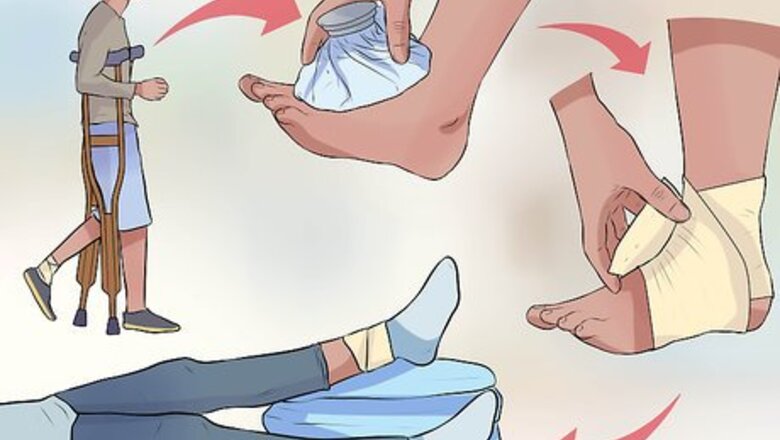
views
X
Trustworthy Source
MedlinePlus
Collection of medical information sourced from the US National Library of Medicine
Go to source
Ligaments in joints heal quickly, and a sprain does not usually require surgery or other intense medical care. However, it is important to properly treat a sprain using first aid techniques so you can heal more quickly.
Taking the First Steps in Treatment
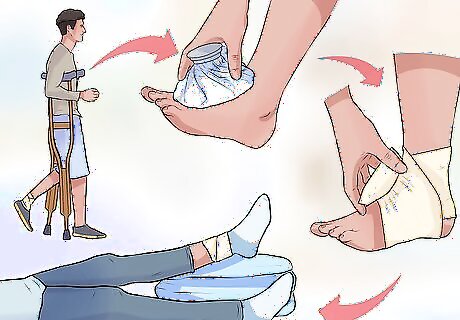
Use the RICE approach recommended by first aid professionals. RICE stands for Rest, Ice, Compress, and Elevate. Incorporate all aspects of this treatment to recover in a timely manner and reduce initial pain and swelling.
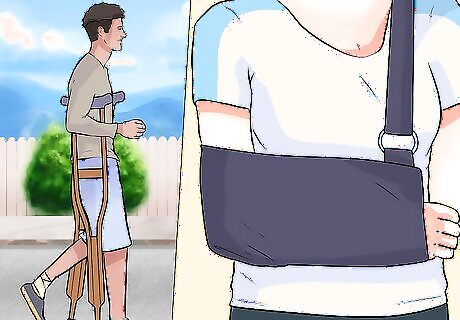
Rest the injured joint by not using it, unless absolutely necessary. Rest is essential to the healing process and to avoid unnecessary pain from the injury. If you must use the joint (e.g., walking), do so with caution and extra support. Use crutches to walk if you sprained an ankle or knee. Wear a sling for wrist or arm sprains. Wrap a splint around a sprained finger or toe and attach it to the digit next to it. Don’t avoid all physical activity because of the sprain, but avoid direct use of the injured joint for at least 48 hours or until the pain subsides. If you are involved in sports, talk to your coach, trainer or doctor about when you can return to sports.
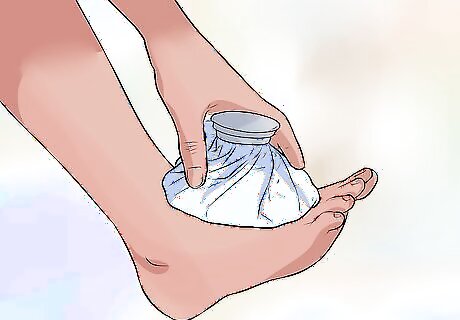
Ice the injured area as quickly as possible. Using an ice pack or cold compress, apply pressure to the injury for up to 3 days until the swelling goes down. Use any form of frozen compress such as ice cubes in a plastic bag, reusable chemical ice packs, a frozen towel, or even bags of frozen vegetables in a pinch. Administer ice treatment within 30 minutes of your injury if possible. Do not apply ice directly to the skin—use a towel or cloth to protect your tissues. Reapply the ice or cold compress every 20–30 minutes throughout the day. Remove the ice or cold compress after treatment and let your skin return to its normal temperature before the next round. Apply the ice or cold compress long enough that you begin to feel the area ache and become slightly numb—this may be 15–20 minutes—which will help reduce pain.
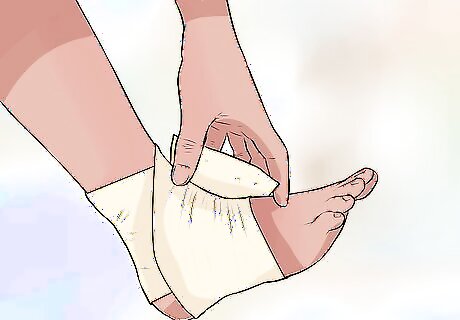
Compress the sprain with a bandage or wrap. This will keep the injured area protected and supported. Wrap the joint tightly but not so tight that your limb becomes numb or tingly. Use a brace for ankles, which may be more effective than a bandage or wrap. Look for elastic bandages or wraps to provide the best support and flexibility. Find supportive athletic tape as an alternative to bandages if necessary. Check with your doctor or pharmacist if you are unsure what type of wrap to use or how to use it.
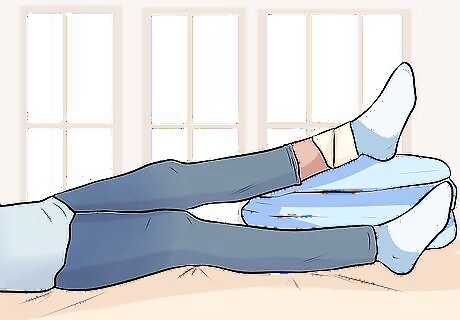
Elevate the sprained joint above your heart, if possible. Elevation helps minimize or prevent swelling. Try to keep the injured body part elevated for 2 to 3 hours each day. Sit or lie down with the injured knee or ankle propped up on a cushion. Use a sling for wrist or arm sprains to bring the limb above the heart. Sleep with your injured arm or leg propped on 1-2 pillows if you are able to. Raise the injured part to the same level as your heart if more elevation is impossible. Beware of any feelings of numbness or tingling and reposition your injured joint if you do; consult a doctor if this continues.
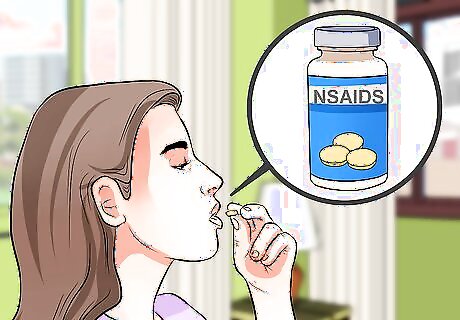
Treat your injury with over-the-counter pain relievers. These can help with pain and inflammation caused by your sprain. However, avoid aspirin, as this promotes bleeding and can therefore cause complications and extreme discoloration of the skin. Look for NSAIDS including ibuprofen (e.g., Advil) or Aleve, which are usually recommended for sprains due to their anti-inflammatory properties. You can also take acetaminophen (e.g., Tylenol) products for pain. Consult a doctor or pharmacist for dosage and the most effective product for you. Ask a doctor or pharmacist about taking these pain relievers if you already take other prescription medications. Follow the product label for dosage and frequency. Be aware of the potential side effects of over-the-counter pain relievers. Use pain relievers together with all aspects of the RICE therapy.
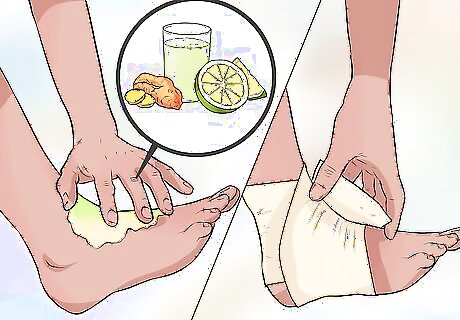
Handle your pain through homeopathic treatments. Although these therapies are not scientifically proven to help ease pain, many people find them helpful. The spice called turmeric is known for its anti-inflammatory properties—mix 2 tablespoons with 1 tablespoon of lime juice and some water into a paste and apply it to the injured joint, then wrap with a bandage for several hours. Find epsom salts at your pharmacy—mix a cup of salts with warm water in a tub or bucket, let them dissolve, and soak the injured joint for 30 minutes up to several times of day. Spread the herbal arnica salve or cream (available at pharmacies) on the injured joint to reduce inflammation and swelling as well as increase circulation; wrap with a bandage after application.
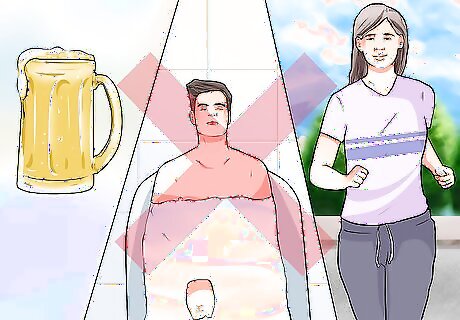
Avoid certain activities than can cause further problems. For the first 72 hours after your injury, it’s essential to be especially cautious. Keep out of hot water—no hot baths, hot tubs, saunas, or hot compresses. Abstain from drinking alcohol, as it increases swelling and bleeding and slows healing. Take a break from strenuous exercise like running, cycling, and other similar sports. Save the massages until the healing phase, as it can promote swelling and bleeding.
Seeking Medical Attention
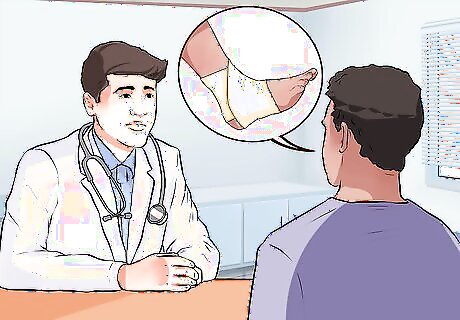
Visit a doctor if the injury does not improve within 72 hours or if you experience symptoms of a broken bone. Anything beyond a simple sprain should be evaluated by medical professionals. Call for medical assistance if you cannot put any weight on the injured limb, as it may be a sign of an especially bad sprain or a broken bone. Avoid trying to tough it out—it’s not worth the risk if the injury is worse than you think. Don’t attempt to diagnose your injury yourself. Seek medical advice to avoid prolonged suffering and/or more injuries and pain resulting from the original sprain.
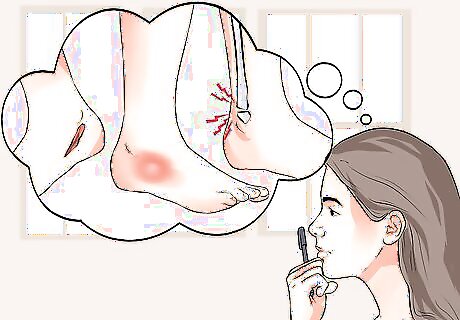
Make note of the symptoms of broken bones. Several characteristics are possible symptoms of a break and the injured party and/or their caretaker should consider them. If you have any of these symptoms, you should seek medical attention. Notice any inability to move the injured joint or limb. Be aware of numbness, tingling, or extreme swelling in the injured joint. Look for open wounds associated with the injury. Recall whether you heard a popping sound when you were injured. Observe the joint or limb for deformity. Note any tenderness to a specific bone in the joint (point tenderness) or significant bruising to the area.
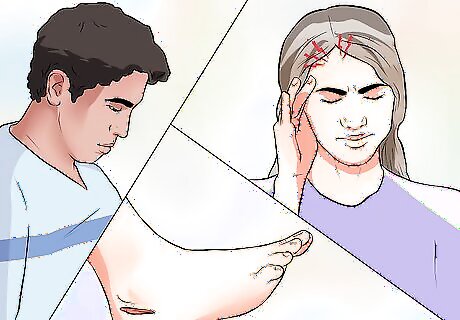
Observe the injury for signs of infection. Any hint of infection needs to be treated immediately to keep it from spreading and making you ill. Look for open cuts or skin abrasions around the injury that could introduce infection. Beware of having a fever within the first hours to first few days of your injury. Examine the injured joint or limb for signs of redness or red streaks branching out from the injured spot. Feel the injured area for warmth or an increase in swelling, a typical sign of infection.

















Comments
0 comment